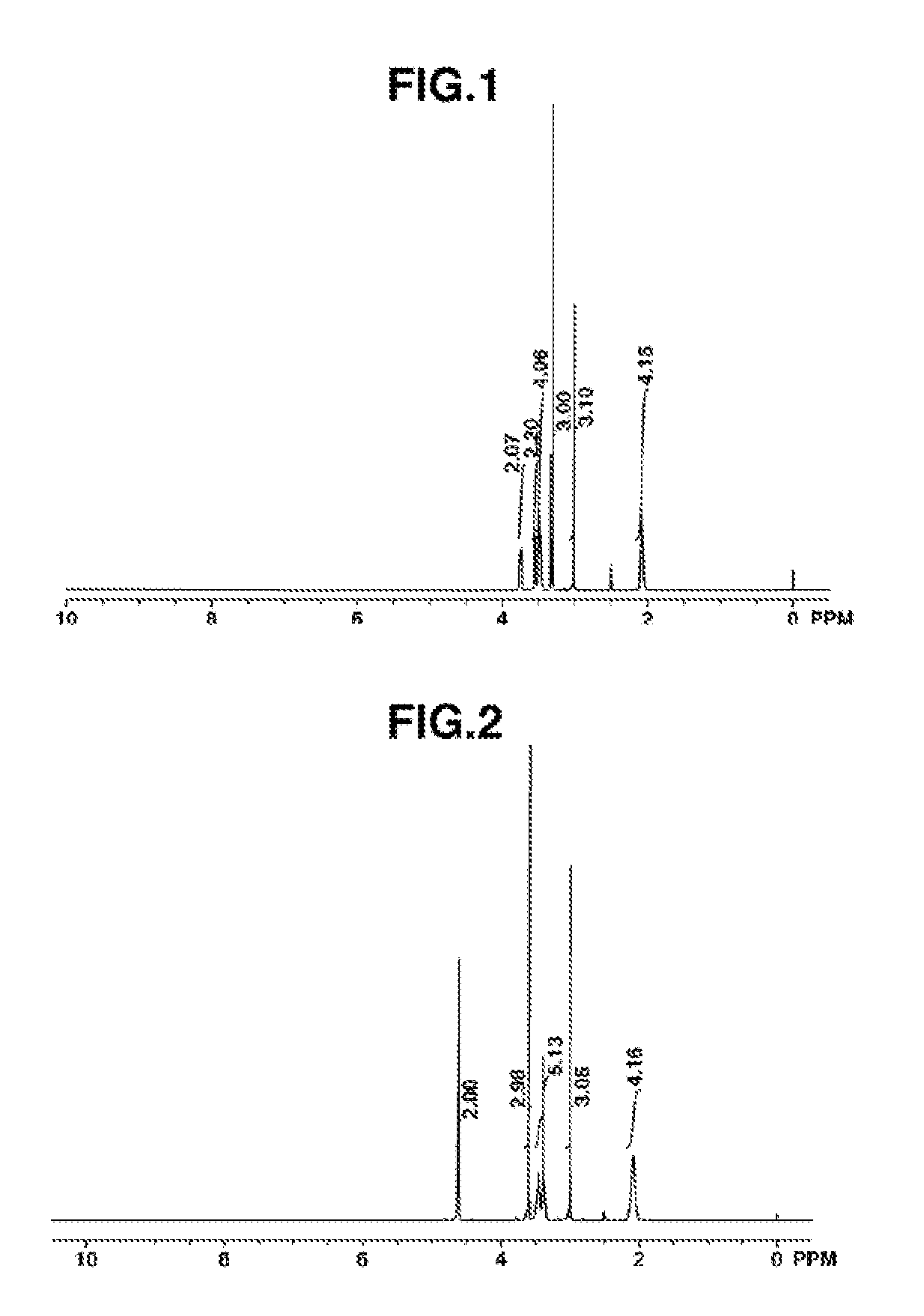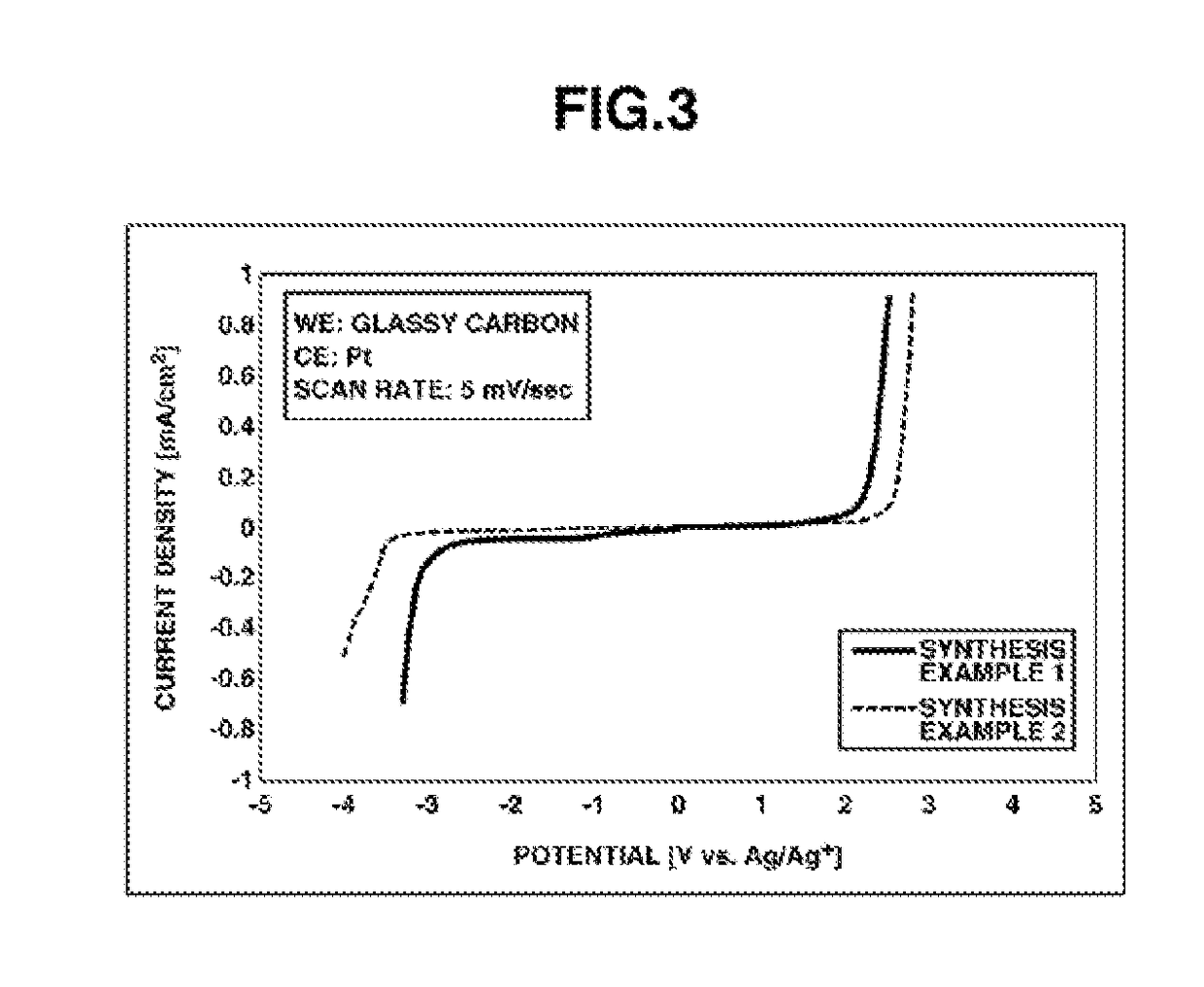Electricity storage device
a technology of electrical energy storage and storage device, which is applied in the direction of electrochemical generators, fuel and secondary cells, organic electrolytes, etc., can solve the problems of increased internal resistance of electrical energy storage device, gas generation and internal shorting due to depletion of electrolyte solution, and the decomposition of organic solvent, etc., to achieve lower solution resistance, lower viscosity, and higher electrical conductivity
- Summary
- Abstract
- Description
- Claims
- Application Information
AI Technical Summary
Benefits of technology
Problems solved by technology
Method used
Image
Examples
synthesis example 1
Synthesis of MEMP•FSA
[0062]
[0063]Pyrrolidine (Wako Pure Chemical Industries, Ltd.), 1.51 parts by weight, and 2-methoxyethyl chloride (Kanto Chemical Co., Ltd.), 1.00 part by weight, were mixed together and reacted for 1 hour under refluxing. Following the reaction, the reaction mixture separated into two layers. When left to cool for a while, the bottom layer solidified. The top layer alone was collected by decantation and purified by vacuum distillation, giving 0.96 part by weight of the target substance N-2-methoxyethylpyrrolidine (boiling point, 76° C.; vapor pressure, 45 mmHg) in a yield of 70%.
[0064]Next, 1.00 part by weight of the N-2-methoxyethylpyrrolidine was mixed with a two-fold volume of toluene (Wako Pure Chemical Industries, Ltd.), the mixture was placed in an autoclave, and the interior of the system was nitrogen purged. The system was closed, after which about 1.00 part by weight of methyl chloride gas (Nittoku Chemicals) was added under stirring at room temperature...
synthesis example 2
Synthesis of MMMP•FSA
[0066]
[0067]A solution of 14.4 parts by weight of N-methylpyrrolidine (Wako Pure Chemical Industries, Ltd.) dissolved in 200 parts by weight of tetrahydrofuran (Wako Pure Chemical Industries, Ltd.) was ice-cooled, and 17.1 parts of chloromethyl methyl ether (Tokyo Chemical Industry Co., Ltd.) was added under stirring. After allowing these to react overnight, the precipitated solids were collected by filtration in vacuo using a Kiriyama funnel. The resulting white solid was dried using a vacuum pump, giving 26.7 parts by weight of the intermediate N-methoxymethyl-N-methylpyrrolidinium chloride (yield, 96%).
[0068]Next, 8.58 parts by weight of the N-methoxymethyl-N-methylpyrrolidinium chloride was dissolved in 10 parts by weight of deionized water. This solution was added under stirring to a solution of 12.5 parts by weight of potassium bis(fluorosulfonyl)amide (Kanto Chemical Co., Ltd.) dissolved in 5 parts by weight of deionized water. Stirring was continued over...
working example 1-1
(1) Production of Positive Electrode Assembly
[0072]A coating slurry for a positive polarizable electrode was prepared by mixing together the activated carbon Maxsorb MSP-20 (Kansai Coke and Chemicals Co., Ltd.), a conductive material (HS-100, from Denka Co., Ltd.) and the binder PVDF (Aldrich Co.) in the weight ratio 85:8:7 within the coating solvent N-methyl-2-pyrrolidone (NMP).
[0073]The slurry was coated on an etched aluminum foil (30B, from Japan Capacitor Industrial Co., Ltd.) as the positive current collector and then rolled using a roll press, following which the NMP was removed by drying so as to form a positive polarizable electrode, thereby giving a positive polarizable electrode assembly.
(2) Production of Negative Electrode Assembly
[0074]A coating shury for a negative polarizable electrode was prepared by mixing activated carbon (LPY039, from Japan EnviroChemicals, Ltd.), a conductive material (HS-100; Denka Co., Ltd.), and the binder PVDF (Aldrich Co.; weight-average mole...
PUM
| Property | Measurement | Unit |
|---|---|---|
| temperature | aaaaa | aaaaa |
| boiling point | aaaaa | aaaaa |
| internal pressure | aaaaa | aaaaa |
Abstract
Description
Claims
Application Information
 Login to View More
Login to View More - R&D
- Intellectual Property
- Life Sciences
- Materials
- Tech Scout
- Unparalleled Data Quality
- Higher Quality Content
- 60% Fewer Hallucinations
Browse by: Latest US Patents, China's latest patents, Technical Efficacy Thesaurus, Application Domain, Technology Topic, Popular Technical Reports.
© 2025 PatSnap. All rights reserved.Legal|Privacy policy|Modern Slavery Act Transparency Statement|Sitemap|About US| Contact US: help@patsnap.com



